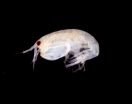Sea lamprey genome mapped with help from scientists at OU
Researchers include McCauley and Clifton
2013-03-01
(Press-News.org) Beginning in 2004, a group of scientists from around the globe, including two University of Oklahoma faculty members, set out to map the genome of the sea lamprey. The secrets of how this jawless vertebrate separated from the jawed vertebrates early in the evolutionary process will give insight to the ancestry of vertebrate characters and may help investigators more fully understand neurodegenerative diseases in humans.
David McCauley, associate professor in the Biology Department in the OU College of Arts and Sciences, and Sandra W. Clifton, with the OU Center for Advanced Genome Technology, collaborated with scientists from Japan, Germany, the United States, Canada and Great Britain.
McCauley isolated and prepared the liver tissue from the single adult female sea lamprey, from which genomic DNA was isolated for sequencing. Clifton was involved in management of the sea lamprey sequencing project at the Genome Institute at Washington University in St. Louis until her retirement in 2010. The project then was taken over by Patrick Minx. Clifton participated in the discussions regarding the paper preparation, and she is a senior author on the paper. Sequencing was performed at the Genome Institute and the project was directed by Weiming Li at Michigan State University with funding provided by the National Human Genome Research Institute at the National Institutes of Health.
"The sea lamprey is a primitive jawless vertebrate that diverged from other jawed vertebrates early in the vertebrate ancestry," writes McCauley. "Because of its early divergence from other living vertebrates, the sea lamprey genome can provide insights for understanding how vertebrate genomes have evolved, and the origins of vertebrate character traits. Several important findings arise from sequencing the sea lamprey genome: Vertebrates have undergone two 'whole-genome' rounds of duplication, resulting in multiple copies of many genes present in vertebrates. One outstanding question has been the timing of these duplications in vertebrate history. Results from this project suggest that two rounds of duplication predated the divergence of the ancestral lamprey from modern jawed vertebrates. This result is important for understanding how vertebrate genomes have evolved, and in particular, for understanding if the organization of the genome is common to all vertebrates.
"Most vertebrates contain an insulating layer of cells that surround nerve cells. Cells that wrap around a nerve fiber, or axon, are enriched in a protein known as myelin. The insulating properties of myelin allow signals to be conducted rapidly along the nerve fiber, and the loss of myelin results in numerous neurodegenerative diseases in humans."
McCauley adds that lampreys lack these "wrapped" neurons, suggesting the insulated neurons are specific to jawed vertebrates. "Somewhat surprisingly, the sea lamprey genome contains multiple proteins involved in the synthesis of myelin, including its basic protein. This important finding suggests the origin of myelin predated the divergence of lampreys from the lineage leading to jawed vertebrates, but the role of these proteins in lampreys is not known. Other important findings shed light on evolution of the vertebrate adaptive immune system, and the evolution of paired appendages, such as fins in fish and fore-limbs and hind-limbs in tetrapod vertebrates such as humans and animals."
###
The findings recently were published in the March issue of Nature Genetics. To read the full article, visit www.nature.com/ng.
ELSE PRESS RELEASES FROM THIS DATE:
Pour, shake and stir
2013-03-01
TORONTO, Ontario (Feb. 28, 2013) - A diagnostic "cocktail" containing a single drop of blood, a dribble of water, and a dose of DNA powder with gold particles could mean rapid diagnosis and treatment of the world's leading diseases in the near future. The cocktail diagnostic is a homegrown brew being developed by University of Toronto's Institute of Biomaterials and Biomedical Engineering (IBBME) PhD student Kyryl Zagorovsky and Professor Warren Chan that could change the way infectious diseases, from HPV and HIV to malaria, are diagnosed.
And it involves the same technology ...
NOAA and NASA's next generation weather satellite may provide earlier warnings
2013-03-01
A new satellite that will detect the lightning inside storm clouds may lead to valuable improvements in tornado detection. The GOES-R satellite is currently being built with new technology that may help provide earlier warnings for severe weather. The national average is a 14-minute lead time to warn residents of a tornado, but NASA and NOAA scientists are looking to improve severe weather detection to save lives and property. They are developing the Geostationary Operational Environmental Satellite-R Series, or GOES-R, to observe thunderstorm development with much greater ...
NASA's Van Allen Probes discover a surprise circling Earth
2013-03-01
After most NASA science spacecraft launches, researchers wait patiently for months as instruments on board are turned on one at a time, slowly ramped up to full power, and tested to make sure they work at full capacity. It's a rite of passage for any new satellite in space, and such a schedule was in place for the Van Allen Probes when they launched on Aug. 30, 2012, to study two giant belts of radiation that surround Earth.
But a group of scientists on the mission made a case for changing the plan. They asked that the Relativistic Electron Proton Telescope (REPT) be ...
Zeroing in on heart disease
2013-03-01
Studies screening the genome of hundreds of thousands of individuals (known as Genome-wide association studies or GWAS) have linked more than 100 regions in the genome to the risk of developing cardiovascular disease. Researchers from the European Molecular Biology Laboratory (EMBL) and the University of Heidelberg, through the joint Molecular Medicine Partnership Unit (MMPU), are taking these results one step further by pinpointing the exact genes that could have a role in the onset of the disease. Their findings are published today in the Public Library of Science (PLoS) ...
New marine species discovered in Pacific Ocean
2013-03-01
HOLLYWOOD Fla. — When Jim Thomas and his global team of researchers returned to the Madang Lagoon in Papua New Guinea, they discovered a treasure trove of new species unknown to science.
This is especially relevant as the research team consisted of scientists who had conducted a previous survey in the 1990s.
"In the Madang Lagoon, we went a half mile out off the leading edge of the active Australian Plate and were in 6,000 meters of water," said Thomas, Ph.D., a researcher at Nova Southeastern University's National Coral Reef Institute in Hollywood, Fla.
"It was ...
BPA raises risk for childhood asthma
2013-03-01
Researchers at the Columbia Center for Children's Environmental Health at the Mailman School of Public Health are the first to report an association between early childhood exposure to the chemical bisphenol A (BPA) and an elevated risk for asthma in young children. BPA is a component of some plastics and is found in food can liners and store receipts.
Results appear in the March edition of the Journal of Allergy and Clinical Immunology.
"Asthma prevalence has increased dramatically over the past 30 years, which suggests that some as-yet-undiscovered environmental exposures ...
Pharmaceutical companies: An $84 million marketing effort in the District of Columbia
2013-03-01
Washington, D.C.—Drug companies spent nearly $84 million marketing pharmaceuticals in the District of Columbia in 2011, including an outlay of nearly $19 million for gifts given to physicians, hospitals and other health care providers, according to a report by researchers at the George Washington University School of Public Health and Health Services (SPHHS). The report notes that 12 physicians in the District received gifts (including consulting payments) that totaled more than $100,000 apiece that one year alone.
"There is nothing inherently wrong with such gifts," ...
Cancer doesn't change young girls' desire to have children, Moffitt Cancer Center study shows
2013-03-01
Researchers at Moffitt Cancer Center and colleagues have found that healthy adolescent females have predetermined expectations for becoming parents in the future, but have concerns about fertility and childbearing should they develop a life-threatening illness, such as cancer.
The study appeared in the February issue of the Journal of Adolescent Health.
According to the researchers, this study helped further validate a tool that seeks to understand teenage girls' hopes and feelings about reproduction, especially when fertility is threatened by cancer. The participants ...
Mother Teresa: Anything but a saint…
2013-03-01
The myth of altruism and generosity surrounding Mother Teresa is dispelled in a paper by Serge Larivée and Genevieve Chenard of University of Montreal's Department of Psychoeducation and Carole Sénéchal of the University of Ottawa's Faculty of Education. The paper will be published in the March issue of the journal Studies in Religion/Sciences religieuses and is an analysis of the published writings about Mother Teresa. Like the journalist and author Christopher Hitchens, who is amply quoted in their analysis, the researchers conclude that her hallowed image—which does ...
Credit card debt expected to rise in 2013
2013-03-01
Credit card debt expected to rise in 2013
Article provided by The Law Office of Lauren Clark, L.L.C.
Visit us at http://www.laurenclarklaw.com
During the recent recession, many Americans imposed austerity measures on themselves. As a result, credit card debt declined. However, recent data indicates that many have become comfortable taking on more debt. According to a report issued by the Federal Reserve Bank of New York, credit card debt rose by $2 billion in the third quarter of 2012, even as the total debt held by Americans dropped by $74 billion.
Data from ...
LAST 30 PRESS RELEASES:
New expert guidance urges caution before surgery for patients with treatment-resistant constipation
Solar hydrogen can now be produced efficiently without the scarce metal platinum
Sleeping in on weekends may help boost teens’ mental health
Study: Teens use cellphones for an hour a day at school
After more than two years of war, Palestinian children are hungry, denied education and “like the living dead”
The untold story of life with Prader-Willi syndrome - according to the siblings who live it
How the parasite that ‘gave up sex’ found more hosts – and why its victory won’t last
When is it time to jump? The boiling frog problem of AI use in physics education
Twitter data reveals partisan divide in understanding why pollen season's getting worse
AI is quick but risky for updating old software
Revolutionizing biosecurity: new multi-omics framework to transform invasive species management
From ancient herb to modern medicine: new review unveils the multi-targeted healing potential of Borago officinalis
Building a global scientific community: Biological Diversity Journal announces dual recruitment of Editorial Board and Youth Editorial Board members
Microbes that break down antibiotics help protect ecosystems under drug pollution
Smart biochar that remembers pollutants offers a new way to clean water and recycle biomass
Rice genes matter more than domestication in shaping plant microbiomes
Ticking time bomb: Some farmers report as many as 70 tick encounters over a 6-month period
Turning garden and crop waste into plastics
Scientists discover ‘platypus galaxies’ in the early universe
Seeing thyroid cancer in a new light: when AI meets label-free imaging in the operating room
Neutrophil-to-lymphocyte ratio may aid risk stratification in depressive disorder
2026 Seismological Society of America Annual Meeting
AI-powered ECG analysis offers promising path for early detection of chronic obstructive pulmonary disease, says Mount Sinai researchers
GIMM uncovers flaws in lab-grown heart cells and paves the way for improved treatments
Cracking the evolutionary code of sleep
Medications could help the aging brain cope with surgery, memory impairment
Back pain linked to worse sleep years later in men over 65, according to study
CDC urges ‘shared decision-making’ on some childhood vaccines; many unclear about what that means
New research finds that an ‘equal treatment’ approach to economic opportunity advertising can backfire
Researchers create shape-shifting, self-navigating microparticles
[Press-News.org] Sea lamprey genome mapped with help from scientists at OUResearchers include McCauley and Clifton


